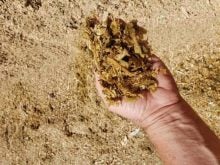As a dairy nutritionist, I often bag a TMR sample from the feed bunk and then later Koster-test its moisture, which should be about 50 per cent. I also do a shaker box test with a three-screen Penn State Particle Separator. I like to see 15-20 per cent long-stem particles in the top-screen, 35-40 per cent in the middle and about 50 per cent on the bottom.
I also look at the nutrient specs of the lactating cows’ feeding program. It should contain at least 28 per cent NDF (75 per cent from forages) and no more than 37 per cent NFC (non-fibre carbohydrates). Lactating cows tend to sort their diet when one of these nutritional parameters is out of balance.
In the same TMR, I also look for other contributing factors that might lead to diet sorting, but they are not always visible, especially when examining my 1/2-kilo sample. That is why I like to consult with a few dairy producers to get more information.
Read Also

Harvest wraps up and fall work begins
At the Eppich famly ranch in western Saskatchewan, the fall harvest was successful with few breakdowns, cows and calves have been sorted and a new tractor has arrived
For example, one producer that milks 150 cows told me they sort their lactation diet when he mixes significant amounts of low-quality forages, despite having a final TMR with a correct dietary moisture level and enough effective forage fibre for good cow rumination.
It’s something that he recently noticed on one particular morning’s higher-than-expected feed refusal (three to four per cent), caused by adding high-fibre grass hay that also contained unpalatable canola stubble to the previous day’s TMR. He figured that the canola stubble hurt their gums. This is something that he never wants to repeat.
Another thing not often apparent in my sample bag is when things actually go according to plan in the lactation barn. This is when there is not a whole lot of sorting, daily feed intake is consistent and feed refusal is at a minimum. For this testimonial, I can use a 350-cow dairy that follows a well-thought-out protocol every day. As a result, this producer delivers an adequately mixed and nutritious TMR to his lactation cows and makes sure it is pushed up several times a day.
A feeding protocol
It goes something like this. At noon every day, in his self-propelled mixer wagon, he mixes up one mix of feed for three to six minutes and dumps it in the feed bunk. Then he makes a second batch, but only dumps about half of that. Together, this feeds all the lactating cows for one day. The next day he dumps the remaining half-mix load from the previous day, then makes up a complete batch and dumps that to completely feed the herd for the second day.
His automatic robot feed-pusher is programmed to move along the feed bunk, where it then augers newly dumped feed, remixes it and pushes it up every 2 ½ hours.
So this producer has very few issues with TMR sorting in his lactation barn. He sees that by pushing up the feed and making it more available to the cows at all times, the cows tend to exhibit less-selective feed behaviour. They get a bellyful of effective forage fibre that promotes good rumination.
The funny thing is that I have been in several dairy barns where the feed isn’t pushed up as often and there are definite “sorting holes” every few feet along the feed bunk. I would expect that these cows are unfortunately consuming an unbalanced portion of their TMR: namely, a lot of easily digested starches. Without enough effective forage fibre to buffer them, the resulting acids from such rapid NFC breakdown cause frequent digestive upsets or subclinical acidosis (SARA) in lactating dairy cows.
In these diet-sorting SARA situations, I make it a point to watch the cows resting in their stalls and watch them chewing their cud. It’s because cows with SARA and other digestive upsets have little rumination activity. So when many of these milk producers are rhythmically belching and chewing without a care in the world, I am confident that sorting of their dairy diet is not occurring to a large extent.
Some behavioural studies suggest that dairy cows are just natural feed-selectors, regardless of how their TMR is put together. Yet I believe we should literally push back on nature to prevent their diet-sorting. Namely, follow some of the above practical suggestions, when mixing up a daily lactation TMR, which needs to be eaten in its entirety by all healthy and productive dairy cows.
















